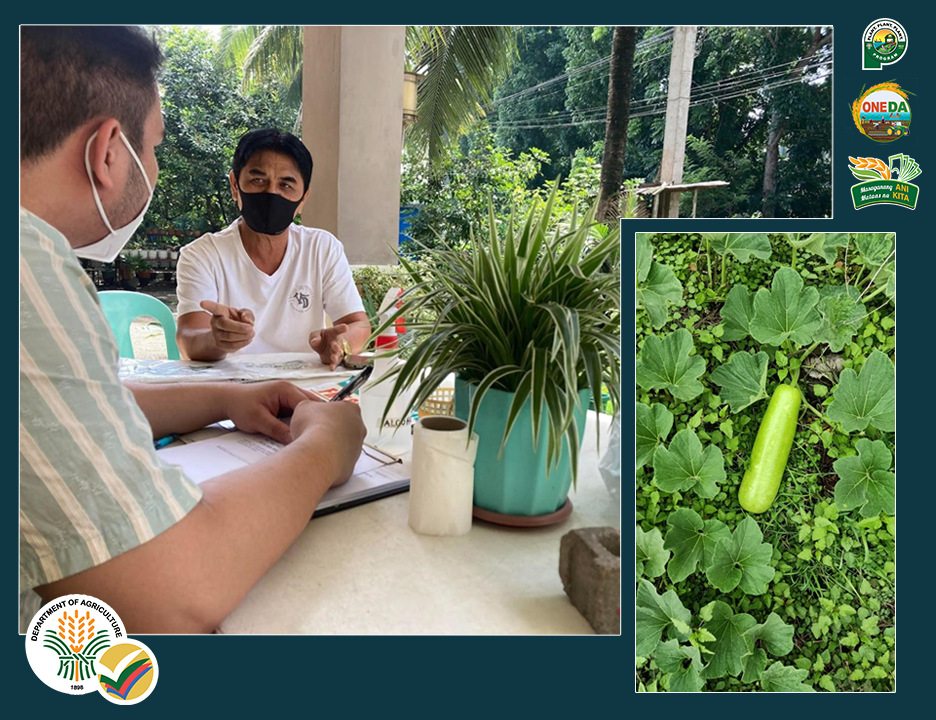
July 28, 2021. Bottle gourd (Lagenaria siceraria), also known as upo, is one of the common indigenous vegetables in the Philippines that is cultivated in areas such as Quezon, Rizal, Siquijor, Ilocos Norte, Ilocos Sur, Nueva Ecija, Surigao Norte and South Cotabato (Altoveros et. al, 2020). A total volume of 73,074.53 metric tons (MT) was produced in a 6,863 hectares of production area (PSA, 2021). Among the regions, Region 4A produced the highest with Quezon as the highest producing province.
According to the High Value Crop Development Program (HVCDP) of DA-CALABARZON, Sariaya and Tiaong have the highest volume of production in Quezon province, 22.1 metric tons and 8.07 metric tons respectively for 2021. The ‘Mayumi’ variety from East West Seed Company was observed to be the most dominant variety used in farms and sold in markets since it has the right size for one serving. Bottle Gourd are produced in two methods, the ground method, wherein the vines are allowed to crawl just above the soil; and trellis method, wherein the vines are allowed to crawl in a vertical structure.
As part of the Standards Development Process, a field data gathering (FDG) was conducted on June 9-11, 2021 in the Municipalities of Sariaya and Tiaong in Quezon Province to validate the current production practices and trading practices.
The FDG team was spearheaded by project managers from BAFS, Mr. Dominique Salcedo and Ms. Krisha Marie Mecija, along with representatives from the Municipal Agriculture Office (MAO) of Sariaya and Tiaong, and relevant stakeholders. They visited the Algonzo and Mendoza Farms in Sariaya, Quezon and Atienza and Satumba Farms in Tiaong. They also observed the trading practices of bottle gourd in the Provincial Market or Pamilihang Bayan of Sariaya Quezon.
Key informant interviews, site observation and confirmation of grading and classification practices were conducted at the Provincial Market or Pamilihang Bayan of Sariaya Quezon. They confirmed the two classes sold in the market – primera/ good, the extra class, and segunda/ semi, the moderate class. Based on the team’s observations, the size, shape, and the smoothness of the fruit are the factors mainly considered in grading.
Being a widely consumed crop, and given the domestic significance of the Bottle Gourd, it is necessary to provide guidance on its minimum quality and food safety requirements. Thus in 2019, The Bureau of Agriculture and Fisheries Standards (BAFS) began the development of the Philippine National Standards (PNS) for the Grading and Classification of Bottle Gourd.
Following the FDG, a series of Technical Working Group (TWG) meetings will be conducted to draft the working draft PNS. It will be followed by a Final Stakeholders Consultation before the finalization of the draft PNS and endorsed for approval by the DA Secretary. The PNS is intended to be used by competent authorities as basis in crafting relevant technical regulations. ###

Figure 2. Bottle Gourd fruit on the ground method of production

Figure 3. Mr. Dominique Salcedo (BAFS Manager) interviews Mr. Perfecto Atienza (Farm Owner)

Figure 1. The field for the ground method of bottle gourd production
References
- Altoveros et al. (2020). Documentation of Indigenous Vegetables Project (Project Report). UPLB-PCCARD. Unpublished Report
- Philippine Statistical Authority (PSA) (2021). Other Crops: Area Planted/ Harvested, by Region and by Province by Semester, 2010-2020. Retrieved from https://openstat.psa.gov.ph/PXWeb/pxweb/en/DB/DB__2E__CS/0072E4EAHO0.px/?rxid=3a201bd3-dece-424b-952e-c7a2c0256a4c- Philippine Statistics Authority (PSA, 2021). Other Crops: Volume of Production, by Region and by Province by Semester, 2010-2020. Retrieved from https://openstat.psa.gov.ph/PXWeb/pxweb/en/DB/DB__2E__CS/0062E4EVCP1.px/table/tableViewLayout1/?rxid=3a201bd3-dece-424b-952e-c7a2c0256a4c
